#phalacrocorax aristotelis
Explore tagged Tumblr posts
Text
In European Shags, males occasionally court other males.
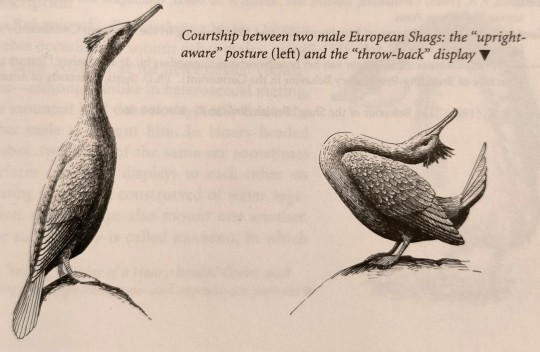
"Biological Exuberance: Animal Homosexuality and Natural Diversity" - Bruce Bagemihl
#book quotes#biological exuberance#bruce bagemihl#nonfiction#european shag#phalacrocorax aristotelis#courtship#gay#upright aware#throw back
21 notes
·
View notes
Text
In addition, about a third of all eggs lost through breakage result from interference by the females in polygamous associations.
"Biological Exuberance: Animal Homosexuality and Natural Diversity" - Bruce Bagemihl
#book quote#biological exuberance#bruce bagemihl#nonfiction#european shag#phalacrocorax aristotelis#eggs#breakage#interference#polygamous
0 notes
Text

European or Common Shags (Phalacrocorax aristotelis), leucistic juvenile amongst normally colored juveniles, family Phalacrocoracidae, order Suliformes, Northern Black Sea Coast, Bulgaria
photograph by Ivaylo Zafirov
#sea bird#cormorant#shag#phalacrocorax#phalacrocoracidae#suliformes#bird#ornithology#europe#animals#nature
371 notes
·
View notes
Text
VARIOUS BIRDS PART 1
There is a wide variety of bird species you can find in the trees and by the water around UEA. These are all part of the same ecosystem by each owning their own niche, increasing the biodiversity of the campus and making a more lively, and loud, environment. In this post I’ve included an odd selection of birds I’ve captured photos of throughout the year. Below is a western jackdaw (Coloeus monedula) in a tree, maybe eyeing up a predator or competitor:

Jackdaws are part of the family Corvidae, and are in the genus closest to that of crows, Corvus. This is obvious by their similarity in appearance. However, western jackdaws are easy to distinguish physically from crows by their slate-grey head tops and light blue eyes (although the immature birds will still have dark plumage and dark eyes). Western jackdaws are known to be highly adaptable and can vary their diet significantly depending on the available food sources, eating anything from small invertebrates such as beetles, flys, butterflies, snails and spiders, small rodents, bats, eggs, roadkill, vegetable items such as grains, seeds, elderberries, acorns, and cultivated fruits. A study conducted in Spain in 1993 found that the Western jackdaws there ate siliceous and calcareous grit to aid in the digestion of vegetable foods as well as supply them with dietary calcium.
Another bird surveying the treetops is this Eurasian blue tit (Cyanistes caeruleus):

This abundant British bird species is extremely easy to identify due to its blue and yellow plumage. They usually feed on several species of insects, although they also like to eat the young buds of trees and seeds. They are mainly known as feeding on coccids (also known as scale insects) and aphids (small sap-sucking insects), two types of insect that can be detrimental to plants. In this way, blue tits play an important role in maintaining the biodiversity of plants in their environments. The also enjoy eating butterflies and moths, such as the wood tiger moth, and can sometimes be seen chasing them through the sky. Another songbird easily recognisable by both its call and its colour is the European robin (Erithacus rubecula). Here is one too-eager-to-be-photographed robin:

Immediately obvious is why the original name in Britain for this birds was ‘redbreast’. In the 15th century, when it became popular for some reason to give human names to bird species it became known as the ‘robin redbreast’, which over time became shortened to plain old ‘robin’. It’s also obvious by this photo that they are remarkably unafraid of people in Britain, and are actually drawn to human activities such as gardening in search of earthworms and other insects. However, in parts of continental Europe, where robins were historically hunted and killed they are much more wary. During the autumn and winter months, when the ground becomes too hard to search for earthworms and insects they will instead feed on berries and fruit. A much bigger bird I spotted perched in a tree over the lake this past year is the great cormorant (Phalacrocorax carbo):

Due to the fact they like to perch on branches near the tops of trees, over bodies of water in order to look for fish to dive down and catch, I wasn’t sure what bird this was when I took the photo. Even zooming in, the quality was too poor (and my bird knowledge not sophisticated enough) for me to positively identify the species. I knew it was in the Phalacrocoracidae family, and narrowed it down to either a shag (Gulosus aristotelis) or a great cormorant, but couldn’t decide. I used this guide below to help, and tried the Seek app, but couldn’t get a positive answer, but now was more sure it was a great cormorant:

My next try, before ashamedly asking my birding friends for help, was to consult an online forum that is dedicated to helping movies identify birds: https://www.reddit.com/r/whatsthisbird/
I posted my photo, gave the time and place if the sighting, and within 10 minutes had a unanimous answer of great cormorant from several strangers who, when I checked their profiles, were serious birders. I found it really inspiring that a community of strangers could help each other in this way, pooling their knowledge and passion into aiding those that didn’t know as much.
This great cormorant was just sitting and waiting for its time to dive down and strike. Cormorants, as well as shags, eat almost nothing else but fish and aquatic creatures such as shrimp, crustaceans and mollusks. They can combine several techniques to catch their prey, such as swallowing smaller prey whole along shallow waters, or diving up to 80m (a feat recorded of the imperial cormorant) to catch food from the sea floor. Due to their large appetites and varied fishing techniques, a large flock of cormorants have been known to deplete a waterway of fish in hours.
0 notes
Photo

Brodarica is a district in Zadar. Brod means ship. Each drawing was done in half an hour, from my own photo reference. 1 Little tree in someone's garden 2 Rowboat & Maraska (abandoned factory building, now owned by foreign investors) 3 in front of a shop in Belafuža 4 Cormorant (Phalacrocorax aristotelis) 5 church in Belafuža 6 the sphinx 7 low tide 8 Boreas, the north wind
More under the tag “razglednice”
#razglednice#sketchbook#portfolio sketchbook#speedpaint#Dalmacija#Zadar#dalmatia#croatia#brodarica#maraska#animals and nature#cormorant#phalacrocorax aristotelis
2 notes
·
View notes
Photo

Phalacrocorax aristotelis by Bill Richmond
#bird#birds#animal#animals#biology#nature#wildlife#fauna#Suliformes#Phalacrocoracidae#Phalacrocorax#Phalacrocorax aristotelis
352 notes
·
View notes
Photo

Shag - Phalacrocorax Aristotelis by creedont Source: http://bit.ly/2KSxW0O
#bird#wildlife#wild#water#sea#ocean#summer#shag#phalacrocorax aristotelis#breeding season#cliff edge
3 notes
·
View notes
Photo

Shag - Phalacrocorax Aristotelis by creedont
1 note
·
View note
Photo



“I made these!” - Shag nest on Staple Island, Farne Islands
46 notes
·
View notes
Photo

April 16, 2017 - European Shag (Phalacrocorax aristotelis)
These cormorants are found around the Atlantic coasts of much of Europe and north Africa and parts of the Black Sea coast. Their diet is made up of a variety of fish, including sandeels, along with other marine prey, such as polychaete worms, cephalopods, other mollusks, and small crustaceans. They often forage alone, but may join flocks of a few hundred birds to follow large groups of fish. Breeding in colonies, they build nests from marine vegetation and flotsam on cliffs and rocky areas. Though they are classified as a species of Least Concern by the IUCN, they face a variety of threats, including persecution from commercial fisheries, predation by American Mink at their nest sites, coastal oil pollution, entanglement and drowning in gill-nets, and possible future outbreaks of Newcastle disease.
#european shag#cormorant#shag#phalacrocorax aristotelis#bird#birds#illustration#art#water#birblr art
1K notes
·
View notes
Video
Shag by Ian Ward
27 notes
·
View notes
Text
Great Cormorants and Shags form mated pairs and generally nest in colonies, which may contain as many as 20,000 pairs in some populations of Great Cormorants.

"Biological Exuberance: Animal Homosexuality and Natural Diversity" - Bruce Bagemihl
#book quotes#biological exuberance#bruce bagemihl#nonfiction#great cormorant#phalacrocorax carbo#european shag#phalacrocorax aristotelis#mated pair#nesting#colony
4 notes
·
View notes
Photo










Cormorán moñudo, corvo mariño cristado (Phalacrocorax aristotelis) / SEO
10 notes
·
View notes
Text
Морские обжоры
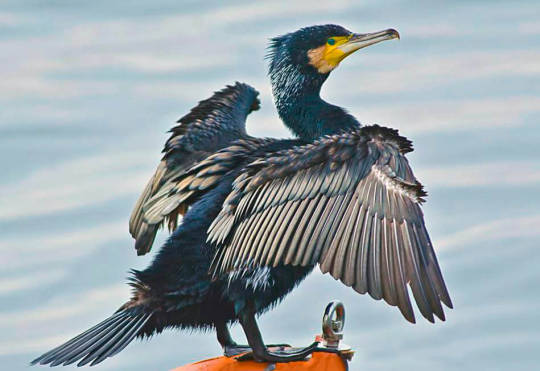
Ну вот мы наконец подошли к самому многочисленному семейству из отряда олушеобразных - баклановым (лат. Phalacrocoracidae), которые насчитывают 42 вида. Это достаточно крупные морские птицы с длиной тела 80-100 см и весом от 1,2 до 3,7 кг, которые распростране��ы очень широко в областях умеренного и тропического климата. Различные виды отличаются по своим конкретным местам обитания, которые охватывают все прибрежные районы Атлантического, Тихого и Индийского океана. Очень часто птицы гнездятся на островах.
У них вытянутое тело, длинная шея, тонкий и длинный клюв, заостренный на конце и по своей форме схожий с рыболовным крючком. Клюв отличается способностью открываться необычайно широко, что позволяет бакланам глотать достаточно большую рыбу. Кроме того на нёбе развиты направленные назад шипы, препятствующие выскальзыванию добычи.
Окрас оперения у многих видов черный с металлическим отливом, встречаются подвиды с белыми отметинами в области головы и живота. На голове, горле, вокруг глаз и клюва есть неоперенные участки кожи, которые в период гнездования обретают красный, зеленый, желтый или коричневый цвет.
Контурное оперение короткое, плотное, крылья относительно короткие, с тупой вершиной, иногда под водой находятся в полусложенном состоянии и служат рулями глубины. Хвост длинный, слабоступенчатый, из 12-16 жестких рулевых, выполняет под водой ту же роль. Благодаря отведенным назад мощным лапам, которые оснащены перепонками, такие птицы, как бакланы, отлично плавают и ныряют, преследую свою добычу под водой. Обычная продолжительность нахождения под водой - 1-2 минуты, а ныряют они на глубину до 10 м.
Перья у бакланов промокают, и птицы вынуждены долго их сушить, расправив крылья, на солнце и ветру.
Летают бакланы неплохо, могут даже планировать, но полет маломаневренный, а взлет с воды требует разбега. Иногда бакланы охотятся с пикирующего полета, как олуши. Существует и нелетающий вид — эндемик Галапагосских островов, где отсутствуют наземные хищники. В результате отказа от полета галапагосский баклан стал самым крупным в семействе и наиболее приспособленным к подводной охоте, но кр��лья его укоротились до 25 см.
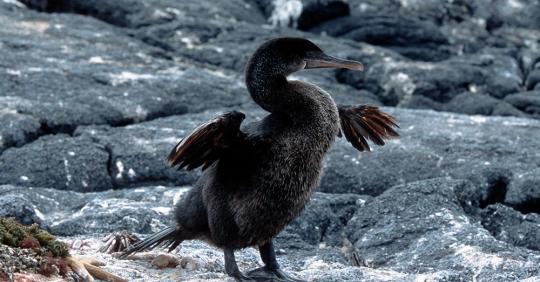
В основном, в рацион бакланов входит мелкая или средняя по размерам рыба: мойва, анчоус, сельдь, сардина. Однако они не брезгуют и моллюсками, раками, лягушками, морскими насекомыми, морскими черепахами и даже змеями.
Традиционно бакланы считаются очень прожорливыми, отсюда и их английское название - “cormorants”, однако установлено, что средняя дневная норма крупных видов составляет всего 300-500 г рыбы. Однако охотятся они большой стаей и являются довольно неприятными соседями для человеческих поселений, ведь приносят большой урон рыбоводческим хозяйствам и обычным рыбакам. Из-за этого бакланов очень часто уничтожали, что привело к исчезновению некоторых популяций.
Наблюдаем за ними в природе:
youtube
Баклановые согласно международной классификации делятся на 3 рода:
Leucocarbo:
Leucocarbo atriceps
Баклан Бугенвиля (Leucocarbo bougainvillii)
Антарктический синеглазый баклан (Leucocarbo bransfieldensis)
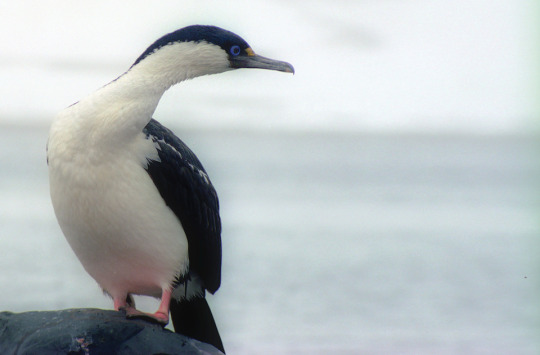
Кэмпбельский баклан (Leucocarbo campbelli)
Новозеландский баклан (Leucocarbo carunculatus)
Leucocarbo chalconotus
Оклендский баклан (Leucocarbo colensoi)
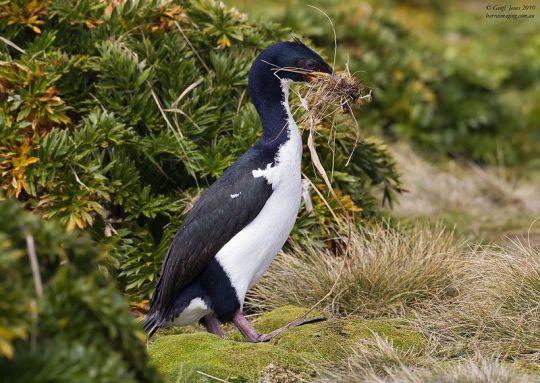
Leucocarbo georgianus
Leucocarbo melanogenis
Leucocarbo nivalis
Leucocarbo onslowi
Leucocarbo purpurascens
Leucocarbo ranfurlyi
Leucocarbo stewarti
Leucocarbo verrucosus
Microcarbo:
Камышовый баклан (Microcarbo africanus)
Чубатый баклан (Microcarbo coronatus)
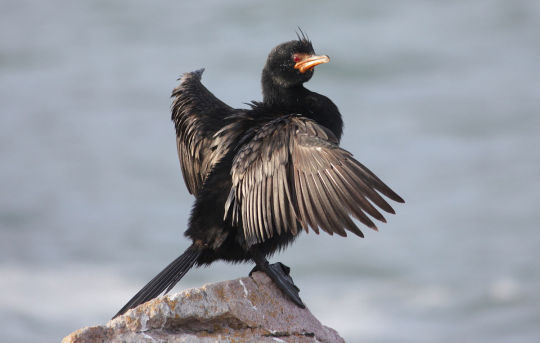
Малый пёстрый баклан (Microcarbo melanoleucos)
Яванский баклан (Microcarbo niger)
Малый баклан (Microcarbo pygmaeus)
Phalacrocorax:
Хохлатый, или длинноносый, баклан (Phalacrocorax aristotelis)
Ушастый баклан (Phalacrocorax auritus)
Phalacrocorax brasilianus
Капский баклан (Phalacrocorax capensis)
Японский баклан (Phalacrocorax capillatus)
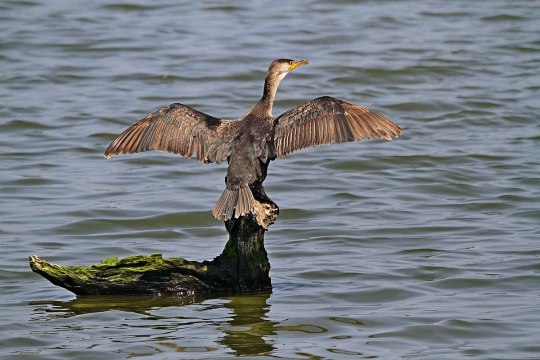
Большой баклан (Phalacrocorax carbo)
Phalacrocorax featherstoni
Белогрудый баклан (Phalacrocorax fuscescens)
Индийский баклан (Phalacrocorax fuscicollis)
Красноногий баклан (Phalacrocorax gaimardi)
Галапагосский нелетающий баклан (Phalacrocorax harrisi)
Phalacrocorax lucidus
Магелланов баклан (Phalacrocorax magellanicus)
Береговой баклан (Phalacrocorax neglectus)
Персидский баклан (Phalacrocorax nigrogularis)
Берингов баклан (Phalacrocorax pelagicus)
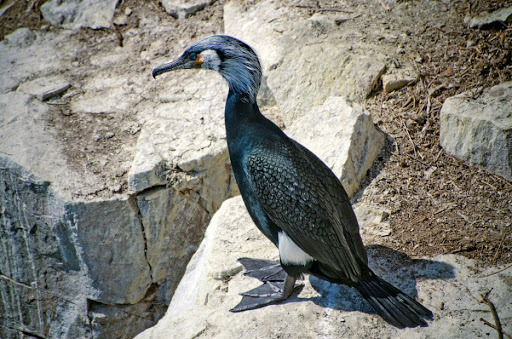
Баклан Брандта (Phalacrocorax penicillatus)
†Стеллеров баклан (Phalacrocorax perspicillatus)
Пятнистый баклан (Phalacrocorax punctatus)
Малый чёрный баклан (Phalacrocorax sulcirostris)
Краснолицый баклан (Phalacrocorax urile)
Пёстрый баклан (Phalacrocorax varius)
Бакланы гнездятся крупными колониями, часто рядом с другими птицами или животными, среди которых чайки, крачки, пингвины, олуши, котики. Свое гнездо птицы сооружают из веточек и травы в ветвях деревьев, иногда на скалах или в тростнике. В одной кладке у самки от 4 до 6 матовых, голубых с белым яиц, которые она откладывает несколько дней подряд. Самка высиживает яйца от 3 до 4 недель. Вылупившиеся птенцы отличаются размерами, у них нет оперения.
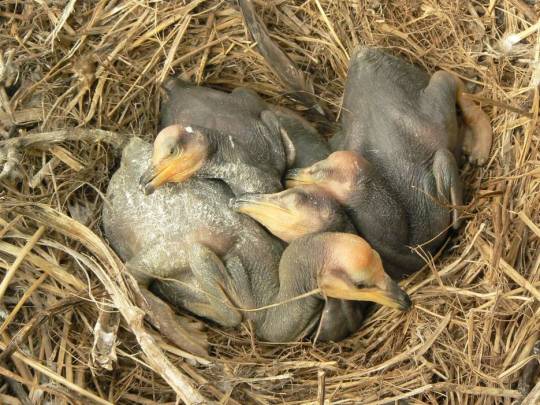
Малыши подрастают и оперяются в зависимости от вида от 35 до 80 дней. Взросление молодой птицы продолжается до 4-летнего возраста. В природе они живут до 20 лет.
Поскольку мясо у бакланов жесткое, темное и пахнет рыбой, они никогда не считались настоящей охотничьей дичью, однако именно преследование из-за мяса стоило жизни одному из видов семейства. Открытый в 1741 г. Георгом Стеллером в ходе Второй камчатской экспедиции Витуса Беринга очковый, или стеллеров, баклан (Ph. perspicillatus) не летал, хотя его крылья подверглись значительно меньшей редукции, чем у галапагосского баклана.
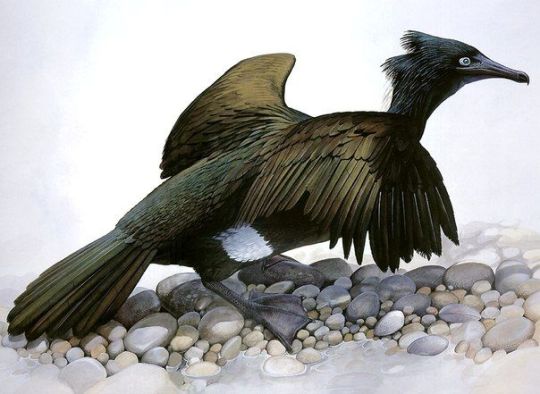
Этот очень крупный, красивый баклан с бледно-желтыми “очками” вокруг глаз, хохлами на лбу и макушке, длинными белыми украшающими перьями на голове и шее был эндемиком Командорских островов. В результате начавшегося в 1826 г., с появлением на архипелаге постоянного населения, хищнического промысла птенцов и яиц, истребления взрослых птиц поселенцами баклан исчез к 1852 г., всего через сотню с небольшим лет после того, как был открыт.
В угрожаемом состоянии находится еще 11 видов бакланов, в основном островные эндемики, в том числе и галапагосский баклан. Война в Персидском заливе в 1992-1993 гг., сопровождавшаяся сильным загрязнением акватории нефтепродуктами, едва не привела к полному исчезновению эндемичного персидского баклана.
Спасибо за внимание!
12 notes
·
View notes
Text
Symbolism
Annoyingly, many people these days, particularly in academic circles, consider symbolism is “condescending.” But I find symbolism deeply meaningful and important. I am using it subtly and sparingly but I love using it. I’m going to just bullet point what I’ve been working on thus far.
One bird that my characters observe is the European Shag, Phalacrocorax aristotelis, as I did when I used to live in the UK. This bird is often mistaken for a Cormorant. According to what I’ve already looked into, European Shags do in fact visit the shore where my characters spend much of their time. Cormorants are traditionally symbols of good luck in China and Japan and bad luck in Ireland. They’re also a sign of adaptability. In Norwegian mythology, “three cormorants flying together are said to be carrying messages and warnings from the dead.” Norwegian myth says that “people who die at sea can visit their former homes in the form of a cormorant.” Milton chose to use the cormorant as a symbol of greed and deception in Paradise Lost when Satan takes the form of the bird to enter Eden and tempt Eve. With symbolism you can pick and choose to a reasonable degree. Even though I’m not using a Cormorant, finding information on European Shag symbolism is nearly impossible to locate, so I’m gonna go with some general symbolism of Cormorants. The connection to the dead is important, as my main character is a soldier who has returned home from the front (World War One). He is in a way visiting his home as a different form of himself, and while he didn’t “die at sea” the Cormorant/Shag is still a version of his former self returning home. Or the Shags could be seen as signs from his former fellow soldier, warning him not to fall prey to his own despair and trauma. There’s really so much to work with. Seeing these beautiful birds at sea made me think of being solitary. They flock in groups but hunt alone. My main OC Marcus is sort of like that; he stays in his group of cousins but he has to do the work of healing from and dealing with PTSD alone. Also, the birds themselves seem sort of ancient and scared, like beautiful dinosaurs.
I’ve worked on names of my character and often name a character based on symbolism. Ironically I didn’t name my main OC’s cousin Nanette because of symbolism; I just liked that name. It’s a Hebrew name meaning "grace" and is diminutive of Ann. Nanette is a writer, mother, and wife, and a person who shows much compassion. She is graceful and she honors him, and anyone who is suffering. My main character’s fiancé is named Jillian, which means “child of the gods” - a feminine form of Julian, meaning “Jove's child.” Jove is a 16th century alternative name for Jupiter the Roman god of thunder and lightning. In a way, Jillian is a godsend to him, a modern woman who is strong but also independent, not meant to “heal him” but to show him understanding while maintaining her own life separate from him.
While I don’t intend to bash my readers over the head with symbolism, it will be present in the novel.
3 notes
·
View notes
Photo



Shag - Galheta (Phalacrocorax aristotelis)
Peniche/Portugal (29/10/2020)
[Nikon D500; AF-S Nikkor 500mm F5,6E PF ED VR with Nikon AF-S TC-14E III; 1/2000s; F8; 400 ISO]
20 notes
·
View notes
